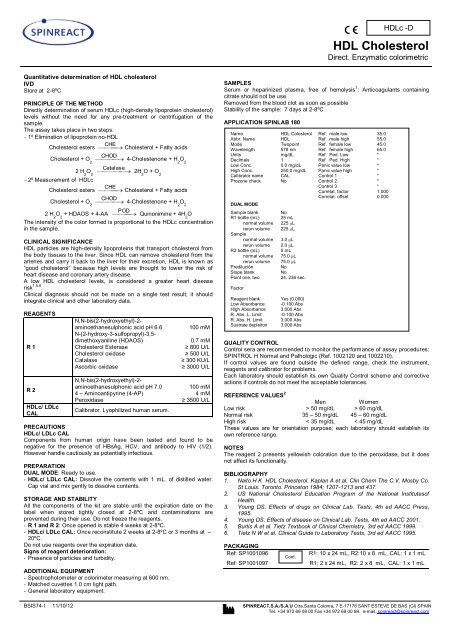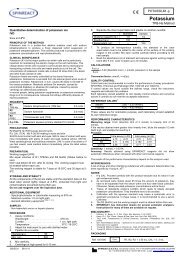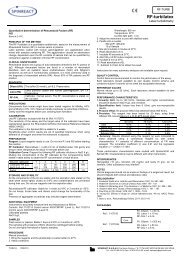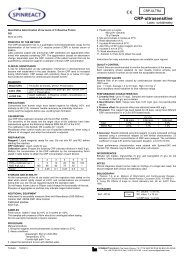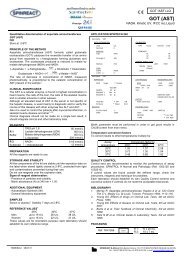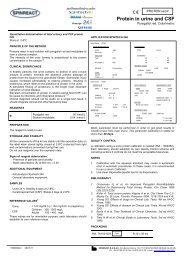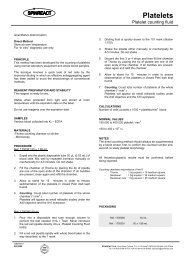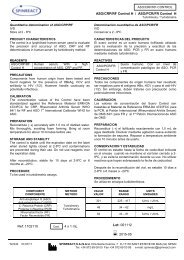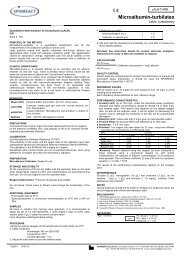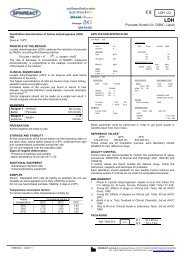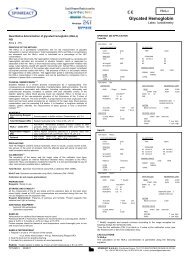HDL Cholesterol - Spinreact
HDL Cholesterol - Spinreact
HDL Cholesterol - Spinreact
You also want an ePaper? Increase the reach of your titles
YUMPU automatically turns print PDFs into web optimized ePapers that Google loves.
Quantitative determination of <strong>HDL</strong> cholesterol<br />
IVD<br />
Store at 2-8ºC<br />
PRINCIPLE OF THE METHOD<br />
Directly determination of serum <strong>HDL</strong>c (high-density lipoprotein cholesterol)<br />
levels without the need for any pre-treatment or centrifugation of the<br />
sample.<br />
The assay takes place in two steps.<br />
1º Elimination of lipoprotein no-<strong>HDL</strong><br />
CHE<br />
<strong>Cholesterol</strong> esters<br />
<strong>Cholesterol</strong> + Fatty acids<br />
<strong>Cholesterol</strong> + O 2<br />
2 H O<br />
2 2<br />
2º Measurement of <strong>HDL</strong>c<br />
<strong>Cholesterol</strong> esters<br />
CHOD<br />
Catalase<br />
CHE<br />
4-Cholestenone + H 2 O 2<br />
2H 2 O + O 2<br />
<strong>Cholesterol</strong> + Fatty acids<br />
CHOD<br />
<strong>Cholesterol</strong> + O 4-Cholestenone + H O<br />
2<br />
2 2<br />
POD<br />
2 H O + HDAOS + 4-AA<br />
Quinonimine + 4H O<br />
2 2 2<br />
The intensity of the color formed is proportional to the <strong>HDL</strong>c concentration<br />
in the sample.<br />
CLINICAL SIGNIFICANCE<br />
<strong>HDL</strong> particles are high-density lipoproteins that transport cholesterol from<br />
the body tissues to the liver. Since <strong>HDL</strong> can remove cholesterol from the<br />
arteries and carry it back to the liver for their excretion, <strong>HDL</strong> is known as<br />
“good cholesterol” because high levels are thought to lower the risk of<br />
heart disease and coronary artery disease.<br />
A low <strong>HDL</strong> cholesterol levels, is considered a greater heart disease<br />
risk 1,5,6 .<br />
Clinical diagnosis should not be made on a single test result; it should<br />
integrate clinical and other laboratory data.<br />
REAGENTS<br />
R 1<br />
R 2<br />
<strong>HDL</strong>c/ LDLc<br />
CAL<br />
N,N-bis(2-hydroxyethyl)-2aminoethanesulphonic<br />
acid pH 6.6<br />
N-(2-hydroxy-3-sulfopropyl)-3,5dimethoxyaniline<br />
(HDAOS)<br />
<strong>Cholesterol</strong> Esterase<br />
<strong>Cholesterol</strong> oxidase<br />
Catalase<br />
Ascorbic oxidase<br />
N,N-bis(2-hydroxyethyl)-2aminoethanesulphonic<br />
acid pH 7.0<br />
4 – Aminoantipyrine (4-AP)<br />
Peroxidase<br />
Calibrator. Lyophilized human serum.<br />
100 mM<br />
0.7 mM<br />
≥ 800 U/L<br />
≥ 500 U/L<br />
≥ 300 KU/L<br />
≥ 3000 U/L<br />
100 mM<br />
4 mM<br />
≥ 3500 U/L<br />
PRECAUTIONS<br />
<strong>HDL</strong>c/ LDLc CAL<br />
Components from human origin have been tested and found to be<br />
negative for the presence of HBsAg, HCV, and antibody to HIV (1/2).<br />
However handle cautiously as potentially infectious.<br />
PREPARATION<br />
DUAL MODE: Ready to use.<br />
- <strong>HDL</strong>c/ LDLc CAL: Dissolve the contents with 1 mL. of distilled water.<br />
Cap vial and mix gently to dissolve contents.<br />
STORAGE AND STABILITY<br />
All the components of the kit are stable until the expiration date on the<br />
label when stored tightly closed at 2-8ºC and contaminations are<br />
prevented during their use. Do not freeze the reagents.<br />
- R 1 and R 2: Once opened is stable 4 weeks at 2-8ºC.<br />
- <strong>HDL</strong>c/ LDLc CAL: Once reconstitute 2 weeks at 2-8ºC or 3 months at –<br />
20ºC.<br />
Do not use reagents over the expiration date.<br />
Signs of reagent deterioration:<br />
- Presence of particles and turbidity.<br />
ADDITIONAL EQUIPMENT<br />
- Spectrophotometer or colorimeter measuring at 600 nm.<br />
- Matched cuvettes 1.0 cm light path.<br />
- General laboratory equipment.<br />
<strong>HDL</strong>c -D<br />
<strong>HDL</strong> <strong>Cholesterol</strong><br />
Direct. Enzymatic colorimetric<br />
SAMPLES<br />
Serum or heparinized plasma, free of hemolysis 1 : Anticoagulants containing<br />
citrate should not be use.<br />
Removed from the blood clot as soon as possible<br />
Stability of the sample: 7 days at 2-8ºC .<br />
APPLICATION SPINLAB 180<br />
Name <strong>HDL</strong> Colesterol Ref. male low 35.0<br />
Abbr. Name <strong>HDL</strong> Ref. male high 55.0<br />
Mode Twopoint Ref. female low 45.0<br />
Wavelength 578 nm Ref. female high 65.0<br />
Units mg/dL Ref. Ped. Low *<br />
Decimals 1 Ref. Ped. High *<br />
Low Conc. 0.0 mg/dL Panic value low *<br />
High Conc. 250.0 mg/dL Panic value high *<br />
Calibrator name CAL Control 1 *<br />
Prozone check No Control 2 *<br />
Control 3 *<br />
Correlat. factor 1.000<br />
Correlat. offset 0.000<br />
DUAL MODE<br />
Sample blank No<br />
R1 bottle (mL) 25 mL<br />
normal volume 225 L<br />
rerun volume 225 L<br />
Sample<br />
normal volume 3.0 L 5.0<br />
rerun volume 2.0 L Vol. repet.<br />
R2 bottle (mL) 5 mL<br />
normal volume 75.0 L<br />
rerun volume 75.0 L Retr., tiemp<br />
Predilución No<br />
Slope blank No<br />
Point one, two 24, 236 sec.<br />
Factor Vol. repet.<br />
Reagent blank Yes (0.000)<br />
Low Absorbance -0.100 Abs<br />
High Absorbance 3.000 Abs<br />
R. Abs. L. Limit -0.100 Abs<br />
R. Abs. H. Limit 3.000 Abs<br />
Sustrate depleiton 3.000 Abs<br />
QUALITY CONTROL<br />
Control sera are recommended to monitor the performance of assay procedures:<br />
SPINTROL H Normal and Pathologic (Ref. 1002120 and 1002210).<br />
If control values are found outside the defined range, check the instrument,<br />
reagents and calibrator for problems.<br />
Each laboratory should establish its own Quality Control scheme and corrective<br />
actions if controls do not meet the acceptable tolerances.<br />
REFERENCE VALUES 2<br />
Men Women<br />
Low risk > 50 mg/dL > 60 mg/dL<br />
Normal risk 35 – 50 mg/dL 45 – 60 mg/dL<br />
High risk < 35 mg/dL < 45 mg/dL<br />
These values are for orientation purpose; each laboratory should establish its<br />
own reference range.<br />
NOTES<br />
The reagent 2 presents yellowish coloration due to the peroxidase, but it does<br />
not affect its functionality.<br />
BIBLIOGRAPHY<br />
1. Naito H K <strong>HDL</strong> <strong>Cholesterol</strong>. Kaplan A et al. Clin Chem The C.V. Mosby Co.<br />
St Louis. Toronto. Princeton 1984; 1207-1213 and 437.<br />
2. US National <strong>Cholesterol</strong> Education Program of the National Institutesof<br />
Health.<br />
3. Young DS. Effects of drugs on Clinical Lab. Tests, 4th ed AACC Press,<br />
1995.<br />
4. Young DS. Effects of disease on Clinical Lab. Tests, 4th ed AACC 2001.<br />
5. Burtis A et al. Tietz Textbook of Clinical Chemistry, 3rd ed AACC 1999.<br />
6. Tietz N W et al. Clinical Guide to Laboratory Tests, 3rd ed AACC 1995.<br />
PACKAGING<br />
Ref: SP1001096 R1: 10 x 24 mL, R2:10 x 8 mL, CAL: 1 x 1 mL<br />
Cont.<br />
Ref: SP1001097 .<br />
R1: 2 x 24 mL, R2: 2 x 8 mL, CAL: 1 x 1 mL<br />
BSIS74-I 11/10/12 SPINREACT,S.A./S.A.U Ctra.Santa Coloma, 7 E-17176 SANT ESTEVE DE BAS (GI) SPAIN<br />
Tel. +34 972 69 08 00 Fax +34 972 69 00 99. e-mail: spinreact@spinreact.com
Determinación cuantitativa de colesterol <strong>HDL</strong><br />
IVD.<br />
Conservar a 2-8ºC<br />
PRINCIPIO DEL MÉTODO<br />
Determinación directa del <strong>HDL</strong>c (colesterol de lipoproteínas de alta<br />
densidad) sin necesidad de pre-tratamiento o centrifugado de la muestra.<br />
La determinación se realiza en dos pasos:<br />
1º Eliminación de lipoproteínas no-<strong>HDL</strong><br />
CHE<br />
Ésteres colesterol<br />
Colesterol + Ácidos grasos<br />
Colesterol + O 2<br />
2 H O<br />
2 2<br />
2º Medición de <strong>HDL</strong>c<br />
Ésteres colesterol<br />
CHOD<br />
Catalasa<br />
CHE<br />
4-Colestenona + H 2 O 2<br />
2H 2 O + O 2<br />
Colesterol + Ácidos grasos<br />
CHOD<br />
Colesterol + O 4-Colestenona + H O<br />
2<br />
2 2<br />
POD<br />
2 H O + HDAOS + 4-AA<br />
Quinonimina + 4H O<br />
2 2 2<br />
La intensidad del color formado es proporcional a la concentración de<br />
<strong>HDL</strong>c presente en la muestra ensayada.<br />
SIGNIFICADO CLÍNICO<br />
Las partículas de <strong>HDL</strong> son lipoproteínas de alta densidad que transportan<br />
el colesterol desde los tejidos del cuerpo hasta el hígado. Debido a que<br />
las <strong>HDL</strong> pueden retirar el colesterol de las arterias y transportarlo de<br />
vuelta al hígado para su excreción, se les conoce como el colesterol o<br />
‘lipoproteína buena’, ya que niveles elevados están relacionados con un<br />
menor riesgo cardiovascular. Un nivel bajo de colesterol <strong>HDL</strong> es<br />
considerado uno de los principales factores de riesgo cardiovascular y<br />
enfermedades de las arterias coronarias 1,5,6 .<br />
El diagnóstico clínico debe realizarse teniendo en cuenta todos los datos<br />
clínicos y de laboratorio.<br />
REACTIVOS<br />
R 1<br />
R 2<br />
<strong>HDL</strong>c/ LDLc<br />
CAL<br />
N,N-bis (2-hidroxietil)-2aminoetanosulfonico<br />
acido pH 6.6<br />
N-(2-hidroxi-3-sulfopropil)-3,5dimetoxianilina<br />
(HDAOS)<br />
Colesterol esterasa<br />
Colesterol oxidasa<br />
Catalasa<br />
Ascórbico oxidasa<br />
N,N-bis (2-hidroxietil)-2aminoetanosulfonico<br />
acido pH 7,0<br />
4 – Aminoantipirina<br />
Peroxidasa<br />
Calibrador. Suero humano liofilizado.<br />
100 mM<br />
0.7 mM<br />
≥800 U/L<br />
≥ 500U/L<br />
≥300 KU/L<br />
≥3000 U/L<br />
100 mM<br />
4 mM<br />
≥ 3500 U/L<br />
PRECAUCIONES<br />
<strong>HDL</strong>c/ LDLc CAL<br />
Los componentes de origen humano han resultado ser negativos para el<br />
antígeno HBs, HCV y para el anti-HIV (1/2). Sin embargo, deben tratarse<br />
con precaución como potencialmente infecciosos.<br />
PREPARACIÓN<br />
MODO DUAL : Reactivos listos para su uso.<br />
<strong>HDL</strong>c/LDLc CAL : Reconstituir el contenido de un vial con 1 mL. de agua<br />
destilada.Tapar el vial y mezclar suavemante hasta disolver su contenido.<br />
CONSERVACIÓN Y ESTABILIDAD<br />
Todos los componentes del kit son estables hasta la fecha de caducidad<br />
indicada en la etiqueta del vial, cuando se mantienen los viales bien<br />
cerrados a 2-8ºC, protegidos de la luz y se evita la contaminación. No<br />
congelar los reactivos.<br />
- R 1 y R 2: Una vez abiertos son estables 4 semanas a 2-8ºC.<br />
- <strong>HDL</strong>c/ LDLc CAL: Una vez reconstituido es estable 2 semanas a 2-8ºC<br />
o 3 meses a –20ºC.<br />
No usar reactivos fuera de la fecha indicada.<br />
Indicadores de deterioro de los reactivos:<br />
- Presencia de partículas y turbidez.<br />
MATERIAL ADICIONAL<br />
- Espectrofotómetro o analizador con cubeta para lecturas a 600 nm.<br />
- Cubetas de 1,0 cm de paso de luz.<br />
- Equipamiento habitual de laboratorio.<br />
<strong>HDL</strong>c -D<br />
Colesterol <strong>HDL</strong><br />
Directo. Enzimático colorimétrico<br />
MUESTRAS<br />
Suero o plasma: 1 No usar anticoagulantes con citrato.<br />
No utilizar muestras hemolizadas. Separar el suero de los hematies lo antes<br />
posible. Estabilidad de la muestra: 7 días a 2-8ºC.<br />
APLICACIÓN AL SPINLAB 180<br />
Nombre <strong>HDL</strong> Colesterol Ref. Hombre Inf. 35.0<br />
Nombre abreviado <strong>HDL</strong> Ref. Hombre Sup. 55.0<br />
Modo Twopoint Ref. Mujer Inf. 45.0<br />
Long. ondas 578 nm Ref. Mujer Sup. 65.0<br />
Unidades mg/dL Ref. Ped. Inf. *<br />
Decimales 1 Ref. Ped. Sup. *<br />
Conc. Inferior 0.0 mg/dL Valor pánico bajo *<br />
Conc. Superior 250.0 mg/dL Valor pánico alto *<br />
Calibrador CAL Control 1 *<br />
Chequeo prozona No Control 2 *<br />
Control 3 *<br />
Factor correl. 1.000<br />
Offset de correl. 0.000<br />
MODO DUAL<br />
Blanco muestra No<br />
Frasco R1 (mL) 25 mL<br />
Vol. normal 225 L<br />
Vol. repet. 225 L<br />
Muestra<br />
Vol. normal 3.0 L<br />
Vol. repet. 2.0 L<br />
Frasco R2 (mL) 5 mL<br />
Vol. normal 75.0 L<br />
Vol. repet. 75.0 L<br />
Predilución No<br />
Pendiente Blco. No<br />
1º, 2º punto 24, 236 seg.<br />
Factor<br />
Blanco reactivo Si<br />
Absorbancia inf. -0.100 Abs<br />
Absorbancia sup. 3.000 Abs<br />
Lim.Inf. Abs. React. -0.100 Abs<br />
Lim.Sup. Abs. React. 3.000 Abs<br />
Agotamiento sustrato 3.000 Abs<br />
CONTROL DE CALIDAD<br />
Es conveniente analizar junto con las muestras sueros control valorados:<br />
SPINTROL H Normal y Patológico (Ref. 1002120 y 1002210).<br />
Si los valores hallados se encuentran fuera del rango de tolerancia, revisar el<br />
instrumento, los reactivos y el calibrador.<br />
Cada laboratorio debe disponer su propio Control de Calidad y establecer<br />
correcciones en el caso de que los controles no cumplan con las tolerancias.<br />
VALORES DE REFERENCIA 2<br />
Hombres Mujeres<br />
Riesgo menor > 50 mg/dL > 60 mg/dL<br />
Riesgo normal 35 – 50 mg/dL 45 – 60 mg/dL<br />
Riesgo elevado < 35 mg/dL < 45 mg/dL<br />
Estos valores son orientativos. Es recomendable que cada laboratorio<br />
establezca sus propios valores de referencia.<br />
NOTAS<br />
El reactivo 2 presenta coloración amarillenta debido a la peroxidasa que<br />
contiene, lo cual no afecta en absoluto la funcionalidad del reactivo.<br />
BIBLIOGRAFÍA<br />
1. Naito H K <strong>HDL</strong> <strong>Cholesterol</strong>. Kaplan A et al. Clin Chem The C.V. Mosby Co.<br />
St Louis. Toronto. Princeton 1984; 1207-1213 and 437.<br />
2. US National <strong>Cholesterol</strong> Education Program of the National Institutesof<br />
Health.<br />
3. Young DS. Effects of drugs on Clinical Lab. Tests, 4th ed AACC Press,<br />
1995.<br />
4. Young DS. Effects of disease on Clinical Lab. Tests, 4th ed AACC 2001.<br />
5. Burtis A et al. Tietz Textbook of Clinical Chemistry, 3rd ed AACC 1999.<br />
6. Tietz N W et al. Clinical Guide to Laboratory Tests, 3rd ed AACC 1995.<br />
PRESENTACIÓN<br />
Ref: SP1001096 Cont. R1: 10 x 24 mL, R2:10 x 8 mL, CAL: 1 x 1 mL<br />
.<br />
Ref: SP1001097 R1: 2 x 24 mL, R2: 2 x 8 mL, CAL: 1 x 1 mL<br />
BSIS74-E 11/10/12 SPINREACT,S.A./S.A.U Ctra.Santa Coloma, 7 E-17176 SANT ESTEVE DE BAS (GI) SPAIN<br />
Tel. +34 972 69 08 00 Fax +34 972 69 00 99. e-mail: spinreact@spinreact.com


